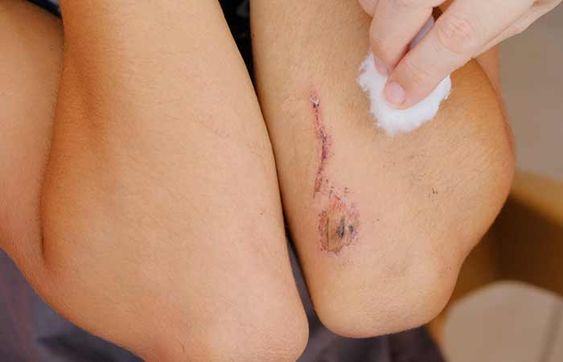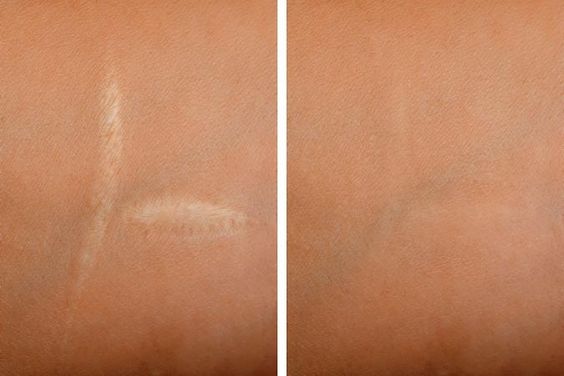When we are injured, the body automatically repairs the wound. However, if there is an abnormality in the wound healing process, it may lead to scarring. Scarring is a common skin problem that can negatively affect appearance and self-esteem. Therefore, for anyone who wants to avoid scarring, it is crucial to understand the wound-healing process and how to promote it.
How the wound came about:
Sometimes carelessness will lead to skin injury. After the injury, there will be wounds and even bleeding symptoms. We must pay attention to timely treatment, otherwise, it will easily lead to inflammation of the wound.
A variety of traumas, often cause skin and soft tissue damage, and even amputation of limbs in severe cases. Correct wound treatment can make it heal quickly; on the contrary, it may be suppurative and infected, which will not heal for a long time, and even be life-threatening due to concurrent systemic infection, gas gangrene, and tetanus. Therefore, traumatic wounds must be treated strictly and seriously.
How do wounds heal?
The healing mechanism of skin wounds can be divided into Repair or Regeneration, and there are clear and important distinctions between the two types of healing. The characteristics and characteristics of the new tissue in wound repair are far inferior to the original tissue, and the goal of wound regeneration is to rebuild the damaged tissue with the same tissue as the original tissue, so as to restore the shape and function of the damaged tissue.
Firstly, wound healing can be divided into 4 phases: hemostatic phase, inflammatory phase, granulation phase or hyperplasia phase, remodeling phase, or maturation phase. When a wound first forms, the tissue is damaged, cells begin to ooze and interstitial fluid leaks out. Next, platelets begin to aggregate, forming a blood clot to help stop the bleeding. Once the clot forms, new blood vessels and tissue begin to grow around the wound. As the wound is about to heal, granulation tissue begins to grow to fill the wound. Eventually, the skin over the wound begins to heal, eventually forming a scar.
How to avoid scars?
Using functional wound dressings:
To avoid scarring, there are many ways to help wounds heal. First, keep the wound clean and dry. If the wound gets wet or contaminated, it can lead to infection and inflammation, which can prevent the wound from healing. Second, functional dressings that promote wound healing, such as hydrocolloid dressings, can be used. This moist healing dressing can provide a slightly acidic space conducive to wound healing, which can make the wound heal faster, prevent the invasion of foreign microorganisms, and reduce the formation of scars. Silicone Scar Dressing can be used after the wound is healed. The breathability of the silicone gel dressing can promote skin regeneration and healing. It keeps the skin dry and relieves itching and discomfort, thereby stimulating skin regeneration. At the same time, the silicon element in the silicone gel dressing can stimulate the production of collagen in the skin, thereby promoting wound healing and reducing the formation of scars.
The waterproof properties of silicone gel dressings prevent fluid from accumulating on the surface of the scar. During the healing process of scars, fluid accumulation and redness often occur, and the waterproof performance of silicone gel dressing can avoid fluid accumulation, thereby reducing inflammation and pain of scars. Silicone gel dressing adopts an elastic design, which can adapt to scars of different shapes, thereby reducing the discomfort of scars, while maintaining the stability of scars, avoiding stretching and pressure on scars during activities, thereby reducing the deterioration of scars.
In conclusion, silicone gel scar dressings can promote skin regeneration and healing, reduce scar inflammation and pain, and stabilize scars through their breathable, waterproof, and elastic design, which is an effective way to reduce scars. Also, avoiding excessive activity and stress, especially during the early wound-healing phase, can reduce scarring.
Nutrition:
Finally, diet and lifestyle also have an impact on wound healing. Research shows that foods rich in antioxidants and vitamins can help speed up wound healing. At the same time, getting enough sleep and maintaining a healthy diet can also promote wound healing. For anyone who wants to avoid scarring, it is crucial to understand the wound-healing process and how to promote it. You can help reduce scarring by keeping the wound clean and dry, using medications that promote wound healing, avoiding excessive activity and stress, and maintaining a healthy diet and lifestyle. In addition, seeking medical help in time is also one of the important measures to avoid scar formation. If the wound is large or there is an infection, it is recommended to seek medical treatment in time to avoid serious complications.
For more information on Innomed®Silicone Scar Dressing, refer to the previous articles. If you have customized needs, you are welcome to contact us; we will serve you wholeheartedly. At Longterm Medical, we transform this data by innovating and developing products that make life easier for those who need loving care.
Editor: kiki Jia
Date: May 24, 2023

 English
English عربى
عربى Español
Español русский
русский 中文简体
中文简体








